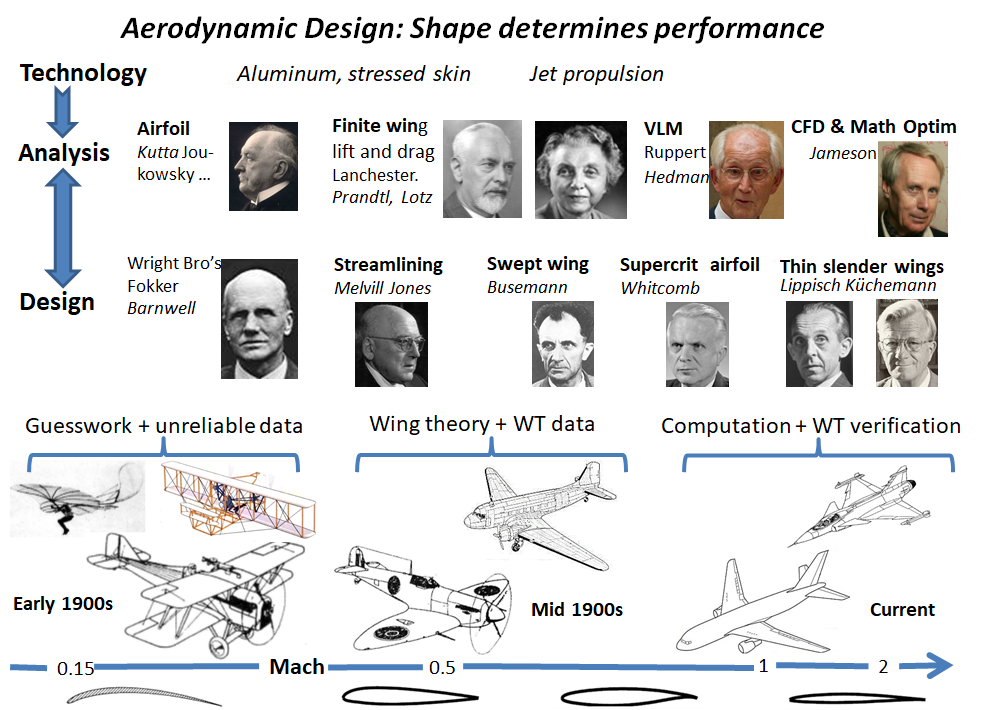

The figure above presents a thumbnail history of the airplane’s aerodynamic development over the twentieth century, including some of the significant contributors who helped to bring it about. This historical overview parallels the organization of our recently published book Aerodynamical Design of Aircraft by Computational Software. We outlined just a hint of this rich history below, with references to which chapters in our book correspond with these milestones.
The design of a new aircraft is a very structured undertaking following a script pioneered by Frank Barnwell in 1917 (Ch 1). Since then aircraft performance has improved enormously by progress in aerodynamics, materials, and propulsion. The task of the aerodynamic designer is to shape the aircraft to meet the performance required for its mission: shape determines aerodynamic performance. Viewed from another perspective, designers use aerodynamic analysis to provide performance data of the shape that makes use of available technology.
The figure starts with the Wright brothers, who built a wind-tunnel to obtain lift and drag data for wing sections. That was needed to estimate the engine power necessary for staying aloft. About the same time, the first mathematical models capable of predicting lift were being worked out by Ludwig Prandtl. His ground breaking boundary-layer theory enabled engineers to better understand airflow quantitatively (Ch 2, 7).
Theory could now be combined with experiment to put more solid data into the designer’s hands, thereby eliminating much of the previous guesswork. For example, the cross-sections of WWI aircraft wings were all thin with small nose radius. The design derived from a misinterpretation of Reynolds number effect in the test data. In 1918 Anton Fokker saw through this error and gave his D-VII aircraft a thick airfoil with large nose radius. That kept the airflow attached at high angles of attack and gave the plane superior climb and maneuver performance.
The next couple of decades bring us from 100 mph contraptions of wood and fabric held together by bracing wires to the sleek shapes of 400 mph WWII fighters. Drag is the force the aerodynamic designer most wants to reduce in every design decision. Melvin Jones’ proposal for “the streamlined aeroplane” showed the gains achievable by cleaning up the shapes to keep the boundary layer attached. The metamorphosis was made possible by technological infusions of materials, structural design and engine power.
Prandtl’s lifting line theory for lift and drag of wings made significant impact on the shapes. The RAF Spitfire’s elliptical wing planform was drag-optimal by theory, and made it iconic (Ch 3). Boundary layer theory does an excellent job in wing section design and the student’s laptop can now analyze a shape in minutes (Ch 7).
The invention of the jet engine changed the game entirely, planes now flew faster and higher. Speeds close to Mach 1 had been achieved in dives and the deleterious effects of shock waves observed, introducing the new design nemesis – wave drag. Wing sweep was suggested by theorist Adolf Busemann, a pioneer in aerodynamics, already in 1935 (Ch 3, 9) as a means to reduce the drag associated with shock waves.
Soon German aerodynamicists showed by experiment that the idea worked. Designs to limit wave drag brought about major changes in both planform and wing cross-section. For swept planforms Whitcomb invented his “supercritical” airfoil to diminish wave drag at transonic speeds. For supersonic flight even more slender delta-shaped planforms were devised with very thin airfoils. However, they gave less lift and were prone to shed a vortex from their leading edge and flew badly close to stall at low speed when high angles of attack were needed. In response Küchemann pioneered the concept of designing for “healthy flow patterns” over slender configurations to achieve the desired performance.
The theoretical models which had served low-speed design so well were useless for speeds approaching Mach 1. But with the cold war on, enormous resources were poured into research and experiments to reach air superiority by speed and altitude. Taking Saab development as an example (Ch 9), the J 29 Tunnan was the first European swept wing fighter in service and made its maiden flight in 1948. Only seven years later the double-delta J 35 Draken flew at Mach 2, and most fighters in service today fly not much faster or higher. The only commercial supersonic airliner was the Concorde, again with an iconic characteristic ogee delta wing shape, also flying at Mach 2.
The development of computer power from 1950 onwards enabled CFD software development for flow predictions at all speeds. The impact was felt decisively from the mid-sixties when machines such as the IBM 7090 and later the IBM System 360 and the Control Data CD 6600 made high-performance computing accessible to engineers. The Vortex Lattice development of the lifting line theory (Ch 3) pioneered by Boeing’s Rubbert and Hedman, became a non-dispensable tool used to this day for low-speed analysis and design, also incorporating the effects of aero-elastic deformations (Ch 11).
Computational models for transonic flow matured and from the eighties on, computer power and software could support algorithmic shape optimization. Antony Jameson’s contributions to both can hardly be overestimated. Many, if not most, of today’s computational fluid dynamics codes, such as the GNU public license SU2, are built from Jameson’s ideas (Ch 6) including the use of an “adjoint” equation to quickly compute the sensitivity of flow results to shape parameters.
For a more complete story of aerodynamic design with all the technical details, turn to our book Aerodynamical Design of Aircraft by Computational Software. Its many examples ofhow shape influences performance are detailed largely by results of computations. The book is accompanied by a web site with tutorials, example projects, and extra material, along with software that enables readers to compute for themselves. Checking, and sometimes challenging, results quoted and trying “what-if” ideas of one’s own are vigorously encouraged!
Latest Comments
Have your say!